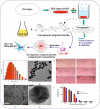The role of deep eutectic solvents and carrageenan in synthesizing biocompatible anisotropic metal nanoparticles
- PMID: 34497740
- PMCID: PMC8381852
- DOI: 10.3762/bjnano.12.69
The role of deep eutectic solvents and carrageenan in synthesizing biocompatible anisotropic metal nanoparticles
Abstract
Plasmonic metal nanoparticles are widely used for many applications due to their unique optical and chemical properties. Over the past decade, anisotropic metal nanoparticles have been explored for imaging, sensing, and diagnostic applications. The variations and flexibility of tuning the size and shape of the metal nanoparticles at the nanoscale made them promising candidates for biomedical applications such as therapeutics, diagnostics, and drug delivery. However, safety and risk assessment of the nanomaterials for clinical purposes are yet to be made owing to their cytotoxicity. The toxicity concern is primarily due to the conventional synthesis route that involves surfactants as a structure-directing agent and as a capping agent for nanoparticles. Wet chemical methods employ toxic auxiliary chemicals. However, the approach yields monodispersed nanoparticles, an essential criterion for their intended application and a limitation of the green synthesis of nanoparticles using plant extracts. Several biocompatible counterparts such as polymers, lipids, and chitosan-based nanoparticles have been successfully used in the synthesis of safe nanomaterials, but there were issues regarding reproducibility and yield. Enzymatic degradation was one of the factors responsible for limiting the efficacy. Hence, it is necessary to develop a safer and nontoxic route towards synthesizing biocompatible nanomaterials while retaining morphology, high yield, and monodispersity. In this regard, deep eutectic solvents (DESs) and carrageenan as capping agent for nanoparticles can ensure the safety. Carrageenan has the potential to act as antibacterial and antiviral agent, and adds enhanced stability to the nanoparticles. This leads to a multidimensional approach for utilizing safe nanomaterials for advanced biomedical and clinical applications.
Keywords: anisotropic nanoparticles; carrageenan; cytotoxicity; eutectic solvents; surfactants.
Copyright © 2021, Das et al.
Figures






Similar articles
-
Plant-mediated green synthesis of metal-based nanoparticles for dermopharmaceutical and cosmetic applications.Int J Pharm. 2021 Mar 15;597:120311. doi: 10.1016/j.ijpharm.2021.120311. Epub 2021 Feb 1. Int J Pharm. 2021. PMID: 33539998 Review.
-
Deep eutectic solvents as efficient solvent system for the extraction of κ-carrageenan from Kappaphycus alvarezii.Carbohydr Polym. 2016 Jan 20;136:930-5. doi: 10.1016/j.carbpol.2015.09.114. Epub 2015 Oct 9. Carbohydr Polym. 2016. PMID: 26572431
-
A Novel Approach towards Synthesis and Characterization of Non-Cytotoxic Gold Nanoparticles Using Taurine as Capping Agent.Nanomaterials (Basel). 2019 Dec 24;10(1):45. doi: 10.3390/nano10010045. Nanomaterials (Basel). 2019. PMID: 31878144 Free PMC article.
-
Deep eutectic solvents: sustainable media for nanoscale and functional materials.Acc Chem Res. 2014 Aug 19;47(8):2299-308. doi: 10.1021/ar5000488. Epub 2014 Jun 3. Acc Chem Res. 2014. PMID: 24892971
-
Pharmaceutical and Biomedical Applications of Green Synthesized Metal and Metal Oxide Nanoparticles.Curr Pharm Des. 2020;26(45):5844-5865. doi: 10.2174/1381612826666201126144805. Curr Pharm Des. 2020. PMID: 33243108 Review.
Cited by
-
New trends in nanobiotechnology.Beilstein J Nanotechnol. 2023 Mar 27;14:377-379. doi: 10.3762/bjnano.14.32. eCollection 2023. Beilstein J Nanotechnol. 2023. PMID: 37025364 Free PMC article. No abstract available.
-
Natural Deep Eutectic Solvents in the Synthesis of Inorganic Nanoparticles.Materials (Basel). 2023 Jan 9;16(2):627. doi: 10.3390/ma16020627. Materials (Basel). 2023. PMID: 36676363 Free PMC article. Review.
-
Potential of a deep eutectic solvent in silver nanoparticle fabrication for antibiotic residue detection.Beilstein J Nanotechnol. 2024 Apr 16;15:426-434. doi: 10.3762/bjnano.15.38. eCollection 2024. Beilstein J Nanotechnol. 2024. PMID: 38655542 Free PMC article.
-
Development, Characterization, and Burn Wound-Healing Potential of Neomycin-Loaded Clay-Reinforced Nanofibers.ACS Omega. 2023 Oct 12;8(42):39014-39022. doi: 10.1021/acsomega.3c03593. eCollection 2023 Oct 24. ACS Omega. 2023. PMID: 37901515 Free PMC article.
-
Design Strategy and Application of Deep Eutectic Solvents for Green Synthesis of Nanomaterials.Nanomaterials (Basel). 2023 Mar 24;13(7):1164. doi: 10.3390/nano13071164. Nanomaterials (Basel). 2023. PMID: 37049256 Free PMC article. Review.
References
Publication types
LinkOut - more resources
Full Text Sources
Miscellaneous
